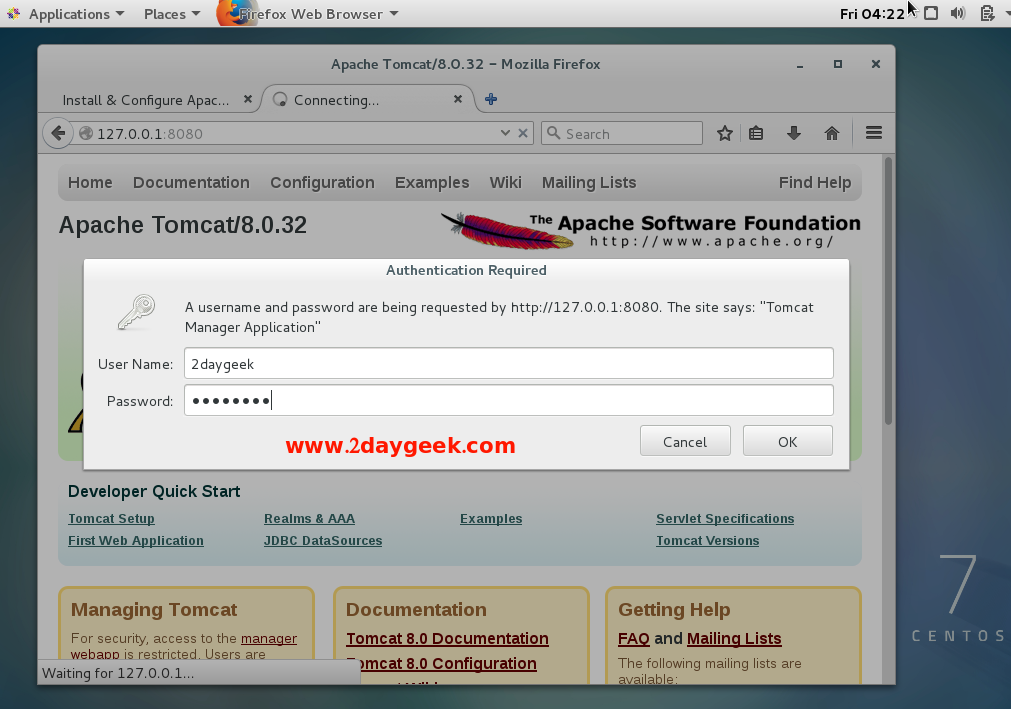

- #APACHE TOMCAT 8 INSTALLATION HOW TO#
- #APACHE TOMCAT 8 INSTALLATION INSTALL#
- #APACHE TOMCAT 8 INSTALLATION UPDATE#
Download Tomcat Binaryįind the latest version of Tomcat 8 at the Tomcat 8 Downloads page.
#APACHE TOMCAT 8 INSTALLATION INSTALL#
The easiest way to install Tomcat 8 at this time is to download the latest binary release then configure it manually. Now that our tomcat user is set up, let’s download and install Tomcat. sudo useradd -s /bin/false -g tomcat -d /opt/tomcat tomcat.We’ll make this user a member of the tomcat group, with a home directory of /opt/tomcat (where we will install Tomcat), and with a shell of /bin/false (so nobody can log into the account): We will create a new user and group that will run the Tomcat service. Create Tomcat Userįor security purposes, Tomcat should be run as an unprivileged user (i.e. Now that Java is installed, let’s create a tomcat user, which will be used to run the Tomcat service. Then install the Java Development Kit package with apt-get:Īnswer y at the prompt to continue installing OpenJDK 7.
#APACHE TOMCAT 8 INSTALLATION UPDATE#
Let’s satisfy that requirement by installing OpenJDK 7 with apt-get.įirst, update your apt-get package index: Tomcat requires that Java is installed on the server, so any Java web application code can be executed. We will be using the demo user created here for the rest of this tutorial.
#APACHE TOMCAT 8 INSTALLATION HOW TO#
You can learn how to do this by completing steps 1-3 in the initial server setup for Ubuntu 14.04. Prerequisitesīefore you begin with this guide, you should have a separate, non-root user account set up on your server. This tutorial covers the basic installation and some configuration of the latest release of Tomcat 8 on your Ubuntu 14.04 server.

Tomcat is an open source implementation of the Java Servlet and JavaServer Pages technologies, released by the Apache Software Foundation. Apache Tomcat is a web server and servlet container that is used to serve Java applications. To verify that Tomcat is working, visit the IP.of.rver:8080 in a web browser. Using CLASSPATH: /opt/tomcat/bin/bootstrap.jar:/opt/tomcat/bin/tomcat-juli.jar Using JRE_HOME: /usr/lib/jvm/java-7-openjdk-amd64/ To activate Tomcat, run the following script: Tomcat and Java should now be installed and configured on your server. bashrc file, then run the following command to register the changes: Likewise, if you installed Tomcat in a different folder other than /opt/tomcat (as suggested) you’ll indicate the path in your bash file and edit the lines above. Older versions of Java may say java-7-openjdk-amd64 instead of java-1.8.0-openjdk-amd64. Verify your file paths! If you downloaded a different version or already installed Java, you may have to edit the file path or name. Next from your server, use wget command to download the tar to the tomcat folder from the URL you copied in the previous step: At the time of this article Tomcat 8 is the newest version but feel free to pick whatever version is more up-to-date. Place your cursor under 8.5.32 Binary Distributions, right click on the tar file and select copy link address (as shown in the picture below). Logged in as root, within the /opt folder make a directory called tomcat and cd into that folder after completion.Ĭd /opt/tomcat Step 2: Install Tomcat Through WgetĬlick this link to the Apache Tomcat 8 Download site. Installing Apache Tomcat 8 Step 1: Create the Tomcat Folder

Be sure you are logged in as root user.This document assumes you are installing Apache Tomcat on Ubuntu 16.04.It is an open-source technology based off Apache. Apache Tomcat is used to deploy and serve JavaServer Pages and Java servlets.


 0 kommentar(er)
0 kommentar(er)
